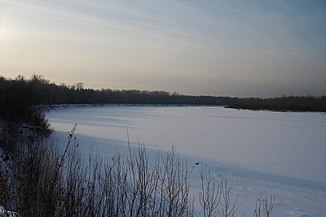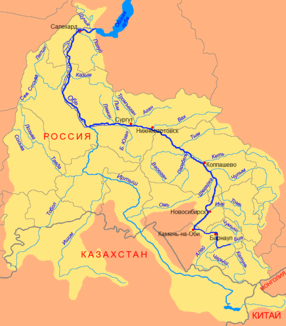Chumysh
|
Tschumysh Чумы́ш |
||
|
Tschumysch in Winter (2005) |
||
| Data | ||
| Water code | RU : 13010200412115200001671 | |
| location | Kemerovo Oblast , Altai Region ( Russia ) | |
| River system | If | |
| Drain over | Whether → Arctic Ocean | |
| confluence | von Kara-Tschumysch and Tom-Tschumysch 53 ° 34 ′ 47 ″ N , 86 ° 37 ′ 6 ″ E |
|
| Source height | 290 m | |
| muzzle |
Whether northwest Barnaul coordinates: 53 ° 31 '48 " N , 83 ° 10' 14" E 53 ° 31 '48 " N , 83 ° 10' 14" E |
|
| Mouth height | 125 m | |
| Height difference | 165 m | |
| Bottom slope | 0.26 ‰ | |
| length | 644 km | |
| Catchment area | 23,900 km² | |
| Discharge at the Jelzowka A Eo gauge : 4340 km² Location: 488 km above the mouth |
MQ 1960/1998 Mq 1960/1998 |
43 m³ / s 9.9 l / (s km²) |
| Discharge at the gauge Kytmanowo A Eo : 11,000 km² Location: 353 km above the mouth |
MQ 1964/2000 Mq 1964/2000 |
76 m³ / s 6.9 l / (s km²) |
| Discharge at the Sarinsk A Eo gauge : 15,900 km² Location: 249 km above the mouth |
MQ 1937/1999 Mq 1937/1999 |
110 m³ / s 6.9 l / (s km²) |
| Discharge at the Talmenka A Eo gauge : 20,600 km² Location: 74 km above the estuary |
MNQ 1943/2000 MQ 1943/2000 Mq 1943/2000 MHQ 1943/2000 |
30.9 m³ / s 131 m³ / s 6.4 l / (s km²) 540 m³ / s |
| Left tributaries | Sary-Chumysh , Taraba | |
| Right tributaries | Uksunai , Sungai , Alambai , Kamenka , Talmenka | |
| Medium-sized cities | Sarinsk , Talmenka | |
| Communities | Jelzowka , Kytmanowo | |
| Navigable | 196 km (limited) | |
|
Course of the Tschumysch (Чумы́ш) in the southeastern catchment area of the Ob |
||
The Tschumysch ( Russian Чумы́ш ) is a 644 km long right tributary of the Ob in Western Siberia ( Russia , Asia ).
course
The Chumysch arises at a height of 290 m in the southeastern part of the Salair ridge , about 40 km southwest of the city of Novokuznetsk in the Kemerovo Oblast , from the source rivers Kara-Chumysch and Tom-Chumysch. Both source rivers, the 173 km long Kara-Tschumysch ("Black Tschumysch") from the left and the 110 km long Tom-Tschumysch from the right, arise about 60 km further north-west as the crow flies, at the level of the city of Kisseljowsk . From their sources they flow roughly parallel to the axis of the mountain ridge in a south-easterly direction to the confluence, the Kara-Chumysch on the north-eastern edge of the mountains to the Kuznetsk Basin , closer to the cities of Kisseljowsk and Prokopjewsk , the Tom-Chumysch in the sparsely populated and densely forested central part of the mountains near the border with the Altai region .
After the confluence, the Tschumysch crosses the Salair mountains in several wide arches and leaves it in a south-westerly direction. In the lowlands that occupy the east of the Altai region as far as the Salair ridge, it then flows in a north-westerly direction in a wide valley that is delimited from that of the Ob by the flat Biysk-Chumysh ridge . It flows around the northwestern end of the ridge, turns to the southwest and finally flows into the Ob, which is more than 500 meters wide at the village of Ust-Tschumysch, about 50 kilometers northwest of the regional administrative center of Barnaul . The Tschumysch meanders strongly along its entire length, especially in the lowland section . Near the mouth it is about 150 meters wide and 2.5 meters deep; its flow velocity there is 0.5 m / s.
The most important tributaries are Uksunai (length 165 km), Sungai (103 km), Alambai (140 km), Kamenka (78 km) and Talmenka (99 km) from the right as well as Sary-Tschumysch (98 km; "Yellow Tschumysch") and Taraba (70 km) from the left.
On the river lie the city of Sarinsk , the urban-type settlement Talmenka and a number of larger villages, including the district administrative centers of Yeltsovka and Kytmanowo , all in the Altai region, while the significantly shorter section of the Chumysh in the Kemerovo Oblast runs through sparsely populated mountainous areas with only a few localities leads.
Hydrology
The catchment area of the Tschumysch covers 23,900 km². The river freezes from the first half of November to the second half of April.
At Talmenka, 74 km above the estuary, the average annual discharge rate is 131 m³ / s with a minimum of 30.9 m³ / s in February and a maximum of 540 m³ / s in May.
Use and infrastructure
The Tschumysch is navigable for smaller vessels from the Sakharovo pier to the mouth for 196 km, but is not considered an inland waterway today.
At Talmenka the railway line Novosibirsk - Barnaul as well as the trunk road M52 ("Tschuja-Trakt") leading from Novosibirsk to the Altai Mountains and to the Mongolian border cross the river, a few kilometers downstream the route of the Central Siberian Railway Omsk - Karassuk - Srednesibirskaja . The middle course of the river from Talmenka to below the village of Shatunowo, where it crosses and leaves the river, is followed by the “Altai – Kuzbass” highway, which in the 1990s followed the prepared route of an extension of the Central Siberian Railway towards the east that was not being built any further was built. The Barnaul - Novokuznetsk railway line crosses the river near the city of Sarinsk. The regional road R367 , which opens up the northeast of the Altai region between Salessowo and Martynowo and crosses it in Sarinsk and Kytmanowo, runs along the river . Further upstream, the Chumysh at Martynowo and Jelzowka crosses the regional road R366 from Biysk to Novokuznetsk.
Individual evidence
- ↑ a b c Article Tschumysch in the Great Soviet Encyclopedia (BSE) , 3rd edition 1969–1978 (Russian)
- ↑ a b Chumysch in the State Water Register of the Russian Federation (Russian)
- ↑ Tschumysch at the Jelzowka gauge - hydrographic data from R-ArcticNET
- ↑ Tschumysch at the Kytmanowo gauge - hydrographic data at R-ArcticNET
- ↑ Chumysch at the Sarinsk gauge - hydrographic data from R-ArcticNET
- ↑ a b Tschumysch at the Talmenka gauge - hydrographic data from R-ArcticNET
- ^ List of Inland Waterways of the Russian Federation (confirmed by Order No. 1800 of the Government of the Russian Federation of December 19, 2002); on-line

